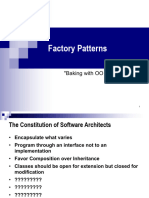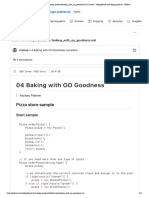0% found this document useful (0 votes)
20 views28 pages04 - Factory Method Pattern
The document discusses the Factory Method design pattern, emphasizing the importance of encapsulating object creation to enhance code flexibility and maintainability. It illustrates the transition from using concrete classes directly to employing a factory that creates objects based on specified types, allowing for easier modifications and extensions. The document also highlights the differences between the Simple Factory and Factory Method patterns, noting that the latter allows subclasses to define the creation logic while maintaining a consistent interface for object usage.
Uploaded by
Batuhan EkinciCopyright
© © All Rights Reserved
We take content rights seriously. If you suspect this is your content, claim it here.
Available Formats
Download as PDF, TXT or read online on Scribd
0% found this document useful (0 votes)
20 views28 pages04 - Factory Method Pattern
The document discusses the Factory Method design pattern, emphasizing the importance of encapsulating object creation to enhance code flexibility and maintainability. It illustrates the transition from using concrete classes directly to employing a factory that creates objects based on specified types, allowing for easier modifications and extensions. The document also highlights the differences between the Simple Factory and Factory Method patterns, noting that the latter allows subclasses to define the creation logic while maintaining a consistent interface for object usage.
Uploaded by
Batuhan EkinciCopyright
© © All Rights Reserved
We take content rights seriously. If you suspect this is your content, claim it here.
Available Formats
Download as PDF, TXT or read online on Scribd
/ 28


























































































